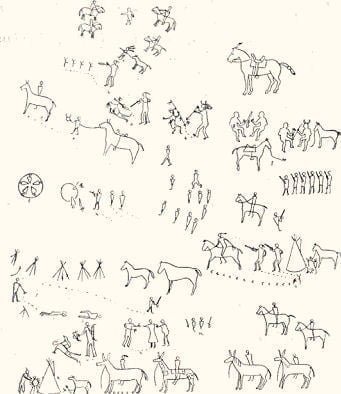Social Distinction. There being no such thing as individual ownership of land, property consisted of horses, food, utensils, etc. These were possessed in varying degrees by the individual members of a tribe, but in no case was the amount of such property given much weight in the determination of social position. Anyone in need of food, horses, or anything whatsoever, was certain to receive some material assistance from those who had an abundance.

Beginning at the top, we have Bear-chief (a) on foot surprised by Assiniboin Indians but he escaped; (b) Double-runner cut loose four horses; (c) Double-runner captures a Gros Ventre boy; (d) Double-runner and a companion encounter and kill two Gros Ventre, he taking a lance from one; (e) even while a boy Double-runner picked up a war-bonnet dropped by a fleeing Gros Ventre which in the system counts as a deed; (f) as a man he has two adventures with Crow Indians, taking a gun from one; (g) he, as leader, met five Flathead in a pit and killed them; (h) a Cree took shelter in some cherry brush in a hole, but Big-nose went in for him; (i) not completely shown, but representing a Cree Indian killed while running off Piegan horses; (j) Double-runner, carrying a medicine-pipe, took a bow from a Gros Ventre and then killed him ; (k) Double-runner took a shield and a horse from a Crow tipi, a dog barked and he was hotly pursued; (m) he killed two Gros Ventre and took two guns; (n) he captured a Gros Ventre woman and a boy; (o) he took four mules.
Among most tribes, the lavish giving away of property was a sure road to social distinction. Yet, the real aristocrats seem to have been those with great and good deeds to their credit. The Dakota, Blackfoot, Cheyenne, and no doubt others, had a more or less definite system for the grading of war deeds, among the highest being the “coup,” or the touching of an enemy. Curiously enough,It this touching as well as capturing a gun was regarded by the Blackfoot, at least, as deserving of greater rank than the mere taking of an enemy s life. The Teton-Dakota, on the other hand, while recognizing the high value of the coup, also put great stress on the taking of a scalp. Running off, or stealing the horses of another tribe, was also a worthy feat among all these Indians. Among most tribes, it was customary at feasts and other gatherings for men to come forward and formally “count” or announce their deeds and often the qualifications for various posts of honor and service were the possession of at least four coups.
The social importance of such deeds naturally developed a kind of heraldry of which the picture writing of the Plains tribes is an example. It was usual to record one’s deeds on his buffalo robe, or on the sides of a tipi (Fig. 38). The Dakota had special rules for wearing eagle feathers in the hair, by which one could tell at a glance what deeds the wearer had performed. The Mandan, Assiniboin, and perhaps others, had similar systems. The Dakota carried the idea over into the decorations for horses and clothing. Even the designs upon their moccasins were sometimes made to emblazon the deeds of the wearer.
